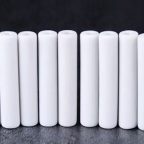At present, the main raw material for the production of special alumina products is industrial alumina, which is an intermediate product of the aluminum smelting industry. Its true density is 3.60g·cm-3, and its mineral composition is γ-Al2O3. Industrial alumina is white powdery material. The chemical composition of general products is shown in the table. When manufacturing special pure products, raw materials with Al2O3 content greater than 99.8% or raw materials prepared from aluminum sulfate and ammonium sulfate should be used. Industrial alumina is difficult to sinter. In order to improve the sintering temperature, the raw materials need to be finely pulverized and pre-sintered, and additives that promote sintering are added. Industrial alumina should be pre-sintered at 1350~1600 ℃ before use.
In order to accelerate the transformation rate of γ-alumina to α-alumina, 3% boric acid is added to promote its better transformation into α-Al2O3, and can reduce the Pre-burning temperature, shorten the holding time and improve the purity of raw materials (Na2O and H3BO3 in the raw materials generate volatile compound sodium borate and run away together). The disadvantage is that the material becomes hard after burning and is not easy to grind. The pulverization fineness plays an important role in the sintering and recrystallization of the green body.
The particle size of the thin-walled products casted by the slurry is less than 2μm, which should account for more than 85%, and the maximum particle size should not exceed 5μm. The particle size of the solid cast original product is less than 2μm, accounting for about 70%. About 50% of the particle size used for machine-pressed blanks is less than 2μm. In order to remove the iron brought in during the pulverization process, it can be treated with hydrochloric acid, and the white α-Al2O3 can be separated after washing with water for many times. It is then dried and crushed to make powder.
Depending on the use, nature, shape and size of the product, alumina products can be formed by the following methods.
- (1) For forming crucibles, pipes and other hollow products, water suspension should be used for casting and forming in plaster models. The moisture requirement for molding is between 20% and 30% (PH value is 6 to 7). In order to improve the strength of the green body, some dry and hard substances such as urea and formaldehyde resin can be added to the slurry.
- (2) Large-scale products can be formed by pressing or air hammering. At this time, the alumina billet should contain barren materials with different particle sizes, such as sintered corundum or fused corundum. Forming by this method requires adding organic plasticizers to the Al2O3 blank, such as dextrin, industrial syrup, carboxymethyl cellulose (CMC for short), polyvinyl acetate, polyvinyl alcohol, etc. The mixed billets can only be used after being trapped (not less than 48h).
- (3) For products with complex shapes and small sizes, hot injection or extrusion methods can be used. Using this method, 1%~2% TiO2 should be added to Al2O3 to reduce the sintering temperature from 1680~1710℃ to 1550~1600℃.
MgO and MgF2 can also promote Al2O3 sintering, but inhibit crystal growth. Therefore, when MgO and MgF2 are added, a microcrystalline structure can be obtained, which is beneficial to the mechanical strength of the product. The fired product needs to be processed and inspected.
Pintejin machining ceramic service include : Alumina Ceramic Parts, Zirconia Ceramic, Silicon Carbide Ceramic, CNC Machined Aluminum Nitride Ceramic, Machinable Ceramic Parts, Glass Ceramic,Macor Ceramic,Powder Metallurgy Dies,Ceramic Injection Molding,Ceramic Dry Pressing,Ceramic Extrusion Dies




